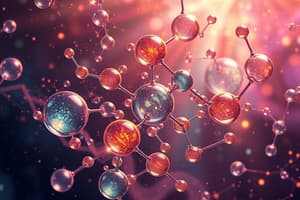Podcast
Questions and Answers
What is the difference between an atom and an element?
What is the difference between an atom and an element?
An atom is the smallest unit of matter, while an element is a pure substance made up of only one type of atom.
List the elements most common in biological organisms.
List the elements most common in biological organisms.
Carbon, Hydrogen, Oxygen, Nitrogen, Phosphorus, and Sulfur.
Which of the six most common biological elements has the most electrons?
Which of the six most common biological elements has the most electrons?
Oxygen.
What is a valence electron?
What is a valence electron?
What are common ions in biology that have gained an extra electron?
What are common ions in biology that have gained an extra electron?
List the types of chemical bonds.
List the types of chemical bonds.
Why do biological ionic compounds dissolve in water?
Why do biological ionic compounds dissolve in water?
Define bonding capacity.
Define bonding capacity.
Flashcards are hidden until you start studying
Study Notes
Chemistry of Elements
- Atom - Single unit of an element. Example: Helium (He)
- Element - Substance made of only one type of atom. Example: Gold (Au)
- Most Common Biological Elements: Carbon (C), Hydrogen (H), Oxygen (O), Nitrogen (N), Phosphorus (P), Sulfur (S).
- Rare Elements in Biology:
- Sodium (Na) and Potassium (K) found in electrolytes and nerve impulses
- Magnesium (Mg) and Calcium (Ca) found in chlorophyll and bone structures
- Valence Electrons: Electrons in the outermost shell of an atom, involved in chemical bonding.
- Carbon (C) has 4 valence electrons, similar to Silicon (Si).
- Nitrogen (N) has 5 valence electrons, similar to Phosphorus (P).
- Oxygen (O) has 6 valence electrons, similar to Sulfur (S).
- Biological Ions:
- Ions are atoms that have gained or lost electrons, forming a charge.
- Anions: Gain electrons, become negatively charged. Example: Chloride (Cl-)
- Cations: Lose electrons, become positively charged. Example: Sodium (Na+)
- Group 1 and 2 elements in the periodic table are most likely to form cations.
- Group 17 elements in the periodic table are most likely to form anions.
- Elements in Biomolecules:
- Carbohydrates: C, H, O
- Lipids: C, H, O (with some P)
- Proteins: C, H, O, N, (with some S)
- Nucleic Acids: C, H, O, N, P
Bonds and Polarity
- Types of Chemical Bonds:
- Covalent Bonds: Sharing of electrons between atoms. Example: Water (H2O)
- Ionic Bonds: Transfer of electrons between atoms, forming ions with opposite charges. Example: Table Salt (NaCl)
- Hydrogen Bonds: Weak attraction between a hydrogen atom covalently linked to an electronegative atom (like oxygen or nitrogen) and a neighboring electronegative atom. Example: Water molecules.
- Covalent Bonds:
- Nonpolar Covalent Bond: Equal sharing of electrons between atoms. Example: Methane (CH4)
- Polar Covalent Bond: Unequal sharing of electrons due to different electronegativity. Example: Water (H2O)
- Electronegativity: The tendency of an atom to attract shared electrons in a covalent bond
- Decreases from top to bottom and from right to left on the periodic table
- Biological Ions:
- Na+, K+, Ca2+, Mg2+ are all cations (positively charged)
- Cl-, PO43-, HCO3- are all anions (negatively charged)
- Electronegativity and Bonding Capacity:
- Bonding Capacity: Refers to the number of covalent bonds an atom can form. Determined by the number of valence electrons available for sharing.
- Electronegativity: Influences the type of bond formed. Higher electronegativity difference leads to more polar bonds.
- Bonding Capacity and Electronegativity together determine the shape and properties of molecules. This is important in biology as it determines interactions between molecules in cells and tissues.
Studying That Suits You
Use AI to generate personalized quizzes and flashcards to suit your learning preferences.




